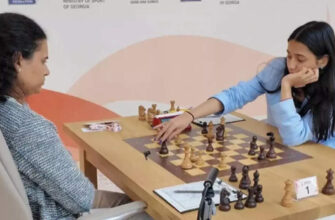The illustrious chessboard, an ancient battleground of intellect and strategy, is currently bearing witness to an unprecedented phenomenon. As the 2025 Women`s Chess World Cup draws to a close, a historic final is set to unfold, featuring two competitors who share not only a passion for the game but also a national identity: India. Koneru Humpy, a name synonymous with resilience and mastery, will face the vibrant, audacious talent of Divya Deshmukh, guaranteeing that the coveted title will, without a doubt, return home to India. This isn`t just a tournament final; it`s a coronation of a new global chess powerhouse.
The Grinding Path to an All-Indian Finale
The journey to this historic final was anything but a leisurely stroll through a park. Both Humpy and Deshmukh had to navigate a formidable gauntlet of opponents, culminating in intense semifinal clashes against players from a nation long considered the bastion of women`s chess: China. For decades, the chess world has looked eastward to China for its female champions, a legacy marked by multiple world titles and an unwavering presence at the top. This tournament, however, has rewritten that narrative with remarkable clarity.
Divya Deshmukh, at a mere 19 years old, showcased a blend of audacious strategy and steely composure far beyond her years. Her path to the final included dismantling two top-ten players and, significantly, her compatriot and world No. 12, Harika Dronavalli. Her semifinal against China`s Tan Zhongyi was a high-wire act of endurance and quick thinking. Despite moments where the tide seemed to turn, Deshmukh capitalised on a late blunder from her experienced opponent, snatching victory from the jaws of uncertainty and securing her place in history.
Koneru Humpy`s journey was equally, if not more, dramatic. Facing Lei Tingjie, Humpy found herself embroiled in a nail-biting series of games that extended into tie-breaks. After drawing the initial 15-minute rapid games and losing the first 10-minute rapid, Humpy was staring down the barrel, needing a win on demand to merely stay in the tournament. In a display that defied pressure and perhaps a touch of fate, she delivered a performance of breathtaking dominance. Every move was calculated, every position commanded, turning what should have been an immense burden into a mere formality. This momentum then carried her through the subsequent blitz tie-breaks, where she ultimately triumphed with a decisive 5-3 scoreline. It was a masterclass in staying calm when the clock ticks loudest.
The Unmistakable Shift: India`s Chess Epoch
This momentous final is not an isolated incident, a flash in the pan. Instead, it serves as a powerful testament to a broader, undeniable trend that has been steadily gaining momentum: the ascendancy of Indian chess. Observers worldwide have noted India`s consistent rise across both men`s and women`s categories. Recent years have seen India secure team gold at the prestigious Chess Olympiad, Koneru Humpy herself claiming the world Rapid championship title, and notably, Gukesh Dommaraju`s phenomenal ascent to become the men`s World Champion. These achievements collectively signify that India`s presence on the global chess stage has evolved from being formidable to overtly dominant. The 2025 Women`s World Cup final, an all-Indian affair, simply cements this reality, delivering a polite but firm declaration that the “winds of power” have decisively, and perhaps irreversibly, shifted eastward.
The era where an Indian champion was a celebrated, yet occasional, exception is evidently drawing to a close. Today, consistent elite performance from Indian chess players is becoming the expected norm, a testament to robust training infrastructure, a burgeoning pool of talented youth, and perhaps a deep-seated cultural appreciation for the strategic profundity of the game. It is a phenomenon that has left many other traditional chess powerhouses, once comfortable in their own reign, in a position of diligent observation and strategic recalculation.
A Generational Clash: Wisdom vs. Daring
The final match-up itself presents a compelling narrative: a captivating clash between generations. Koneru Humpy, with her extensive decades of experience, a cabinet full of titles, and a reputation as one of the most tenacious competitors on the circuit, embodies the established excellence of Indian chess. Divya Deshmukh, barely stepping into her twenties, represents the vibrant, fearless future – innovative, daring, and rapidly ascending the global rankings with a confident stride. While Humpy undoubtedly brings a higher ELO rating and a vastly more extensive career résumé, Deshmukh`s recent performances against top-tier opponents have positioned her as an undeniable equal in terms of current form and sheer momentum. It`s a contest where experience will meet an almost audacious lack of fear.
“I think it`s one of the happiest moments for our chess fans, because the title is India`s for sure. It will be a tough game, Divya has played tremendously well throughout the tournament,” Humpy graciously remarked after her semifinal victory, encapsulating the sentiment perfectly.
Beyond the Board: The Road to the Candidates and Future Prospects
Beyond the immediate excitement and prestige of the World Cup final, the implications for Indian chess are profound and far-reaching. Both Koneru Humpy and Divya Deshmukh have now officially secured their coveted spots in next year`s FIDE Candidates Tournament, a critical stepping stone towards challenging for the ultimate prize: the Women`s World Championship title. Furthermore, with other formidable talents such as R. Vaishali and Harika Dronavalli consistently performing at elite levels, the prospect of having a significant contingent of Indian players at the Candidates is no longer just plausible but highly anticipated. What once would have elicited widespread awe and surprise, now merely earns a nod of informed expectation – a subtle, yet significant, shift in perception.
As the final weekend of the 2025 Women`s Chess World Cup approaches, all eyes will be fixed on the 64 squares, watching these two exceptional Indian players vie for one of chess`s most prestigious honors. Regardless of whether the gleaming trophy ultimately finds its permanent home in Maharashtra or Andhra Pradesh, one thing remains abundantly and unequivocally clear: the true, resounding victor at the end of this captivating saga will, once again, be Indian chess.









